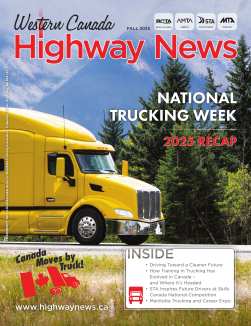
A Tale of Two Crises: Why (Proper) Regulation is Essential to this Essential Industry
September 23, 2020
Author: Clayton Barry, Partner, McDougall Gauley LLP, Saskatoon, SK Clayton Barry serves on the Saskatchewan Trucking Association Board of Directors

It is well known that transportation is a heavily regulated industry. Two recent events of national significance – the Humboldt bus crash and the global pandemic – demonstrate how crisis has had a dramatic effect on the public’s perception of the industry. These events also reflect how the regulation of this complex and essential industry can lead to unintended consequences. In the case of the current pandemic, the recognition of drivers as essential has placed the spotlight on trucking in a positive way. In the case of the Humboldt bus crash, the mandatory entry-level training legislation has dramatically reduced the number of new drivers coming into the industry, thereby exacerbating a long standing recruitment issue.
The global pandemic is changing our world in ways previously deemed unimaginable, and the change is lightning fast. For some businesses, like Amazon, the change has been overwhelmingly positive and profitable. For others, like hotels, restaurants, and airlines, the change has been profoundly negative. The line that COVID-19 has drawn in the sand is unforgiving. The same is true for trucking companies; depending on the client base and the industry served, business has been either good or very good, or bad or very bad. Regardless, our drivers and the industry as a whole are enjoying 15 minutes of fame. This is, in part, because of the action of federal and provincial governments in passing laws that recognize trucking as ‘essential.’
In an effort to keep supply chains intact, the Government of Canada granted various orders pursuant to the Quarantine Act that exempted truck drivers from the 14-day quarantine rule upon returning to Canada and acknowledged transportation as an essential service. Truck drivers, like health care professionals, pharmacists, food manufacturing employees, grocery clerks, and agricultural workers were deemed to be essential to national safety and security.(1)
Similarly, the Province of Saskatchewan issued a Public Health Order on March 26, 2020 naming transportation as a ‘critical public service.’(2)
In all, 14 critical infrastructure sectors were recognized by the Federal Government, and in order for each sector to carry out its respective critical work for Canadians, trucks, trailers, and drivers are needed. Not only are truck drivers essential but they are critical to the proper work and function of every other essential service. The pandemic has amplified the notion that trucking is the lifeblood of industry.
While the majority of Canadians were at home on lockdown, truck drivers went to work – just as they do during snowstorms, Christmas day, Friday nights, and despite scheduled family gatherings.
Like never before, the nation and government focused on ensuring drivers had what they needed to carry out their essential work. Drivers were empowered to do their job. Where would ‘our’ drivers get food on the road, where would they find washroom facilities and other supplies during the lockdown? How can we keep drivers safe from the risk of getting sick while operating in the ‘hot spots’?
The community responded in a truly Canadian way and the social media hashtag #ThankATrucker began trending, as did the phrase ‘tip your hat to a trucker.’ Restaurants and hotels gave VIP treatment to drivers, offering in many instances meals and lodging free of charge.
In an effort to get the message out, the Saskatchewan Trucking Association (STA) published a meal and accommodation guide containing contact information for businesses wanting to support drivers. In many instances, businesses were willing to meet drivers on their routes. Meal options were no longer limited by parking lot size.
Stories of drivers being thanked and applauded in public by strangers were being shared. In some instances, drivers were ushered to the front of restaurant lines and had meals purchased for them. For drivers who have worked hard to address reputational issues and other challenges facing the industry, they experienced a ‘pinch me’ moment – and maybe more than one.
Suddenly, the law and the authority of government that drivers ‘sometimes’ perceive to be an obstacle in their daily working lives was supporting and enabling drivers. Hours of service regulations were relaxed for federal carriers transporting essential supplies,(3) and, for a time, the Wile E Coyote stopped chasing the Roadrunner.
In May of 2020, TruckingHR Canada surveyed 1,800 Canadians about how the pandemic impacted the public’s perception of trucking.(4) The results were positive and showed a shift in the perception of the industry to positive or very positive:
- 29% said their impression of the industry improved as a result of the pandemic;
- 72% agreed that trucking companies were essential; and
- 80% said that trucking is an essential sector in the Canadian economy.
In stark contrast is the negative public perception hampering the industry as a consequence of the Humboldt Broncos bus crash.
These two historical events have each had a very significant, yet immensely different impact on the trucking industry.
To protect the public and to address the education and training deficit for entry-level drivers that became apparent as a result of the Humboldt bus crash, federal and provincial governments implemented mandatory entry-level training (MELT).
Effective March 15, 2019, MELT became mandatory in Saskatchewan for new drivers seeking a Class 1 commercial license. MELT requires a minimum of 121.5 hours of training, which includes 47 classroom hours, 17.5 hours in the yard, and 57 hours behind the wheel.
To address the increased cost for new drivers, the Canada-Saskatchewan Job Grant was implemented in April 2019 and provides up to $10,000 for every trainee. To qualify for the grant, a prospective driver needs to have an employer and a job.
The following statistics made available by SGI demonstrate that since the implementation of MELT the number of new Class 1A drivers graduating has decreased dramatically:
- 2,484 Class 1A licenses were issued in Saskatchewan in 2017;
- 2,796 Class 1A licenses were issued in Saskatchewan in 2018;
- 2,204 Class 1A licenses were issued in Saskatchewan from January 1 – March 15, 2019;
- 318 Class 1A licenses were issued in Saskatchewan from March 15, 2019 – Dec 4, 2019,
- 349 applicants received funding since the Canada-Saskatchewan Job Grant was implemented in April 2019; and
- Under MELT the road test passing rate is 63% and the written class 1 component of MELT has a 29.4% pass rate.
While it is difficult (actually impossible) to argue that increased education is not a laudable goal for the industry and much needed, statistics show that under MELT, the future of the industry is in danger. Regulation aimed at improving safety, is unintentionally harming the industry in a serious way and cannot be ignored. The economy needs drivers to perform the work that has been recognized as essential, but there are significantly fewer drivers graduating into the profession.
Despite the reputational booster shot the industry received as a result of the pandemic, the TruckingHR Canada results also demonstrate that the industry still struggles with the challenging reality that people are reluctant to join the industry. Only 16% of respondents answered that they strongly agree young Canadians should be encouraged to consider working for a trucking company, and 48% answered that they would not consider a job in the industry.
The STA has launched the We are Trucking marketing campaign aimed at recruitment, retention, and improving the image of trucking. The STA and trucking associations are doing what they can, but government and regulation are needed to make the dramatic changes required. Although related, the issues are bigger than image.
Who can blame people for being reluctant to enter the vocation of a professional driver? The transportation industry is one of the most intensely regulated industries, and arguably it is over regulated. The layering effect from multi-jurisdictional regulations is at times unnavigable, and the rigidity of hours of service laws hurts driver retention and recruitment. The job is becoming more and more complex, and there are more and more laws for a driver to potentially run afoul and face punishment. In the name of safety, some companies are considering the installation of dash cams to record all driver movements and action while on shift. All of this adds stress to an already stressful occupation. While other industries are altering work schedules, encouraging workers to work remotely, and providing flexibility for modern life and family needs, the trucking industry continues to add stressors for drivers and struggles to ensure drivers have basic needs like washrooms and rest stops, even though government mandates the frequent use of rest stops.
The industry and government have an opportunity to use the momentum and lessons arising from the pandemic to improve the working lives of drivers. In so doing, the industry must carefully craft its response being mindful of unintended consequences, such as the depletion of new graduates in the post-MELT era. It must control its own destiny by implementing regulation that places the needs of its drivers at the forefront. The industry cannot bounce from crisis to crisis hoping for positive change and momentum. People want to work in a profession that is recognized as having a critical role in the function of the Canadian economy; not a profession associated with tragedy.
1 “Guidance on Essential Services and Functions in Canada During the COVID-19 Pandemic,” Government of Canada, last modified May 5, 2020, https://www.publicsafety.gc.ca/cnt/ntnlscrt/crtcl-nfrstrctr/esf-sfe-en.aspx.
2 “Critical Public Services, Allowable Business Services and Events, Activities, and Outdoor Spaces,” Government of Saskatchewan, https://www. saskatchewan.ca/government/health-careadministration-and-provider-resources/ treatment-procedures-and-guidelines/ emerging-public-health-issues/2019-novelcoronavirus/public-health-measures/publichealth-orders/list-of-critical-public-servicesand-allowable-business-services#list-a.
3 “Essential Freight Transport Exemption,” Canadian Trucking Alliance, March 24, 2020, http://cantruck.ca/wp-content/ uploads/2020/03/Signed-EN-EssentialFreight-Transport-Exemption_public.pdf.
4 “How Has the Pandemic Impacted the Impression of Trucking & a Career in Trucking?” TruckingHR Canada, May 2020, https://truckinghr.com/wp-content/ uploads/2020/05/Trucking-HR-COVID-19- May-2020.pdf.




